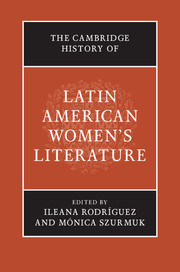
- Publisher:
- Cambridge University Press
- Online publication date:
- November 2015
- Print publication year:
- 2015
- Online ISBN:
- 9781316050859


The Cambridge History of Latin American Women's Literature is an essential resource for anyone interested in the development of women's writing in Latin America. Ambitious in scope, it explores women's literature from ancient indigenous cultures to the beginning of the twenty-first century. Organized chronologically and written by a host of leading scholars, this History offers an array of approaches that contribute to current dialogues about translation, literary genres, oral and written cultures, and the complex relationship between literature and the political sphere. Covering subjects from cronistas in Colonial Latin America and nation-building to feminicide and literature of the indigenous elite, this History traces the development of a literary tradition while remaining grounded in contemporary scholarship. The Cambridge History of Latin American Women's Literature will not only engage readers in ongoing debates but also serve as a definitive reference for years to come.
 Loading metrics...
Loading metrics...
* Views captured on Cambridge Core between #date#. This data will be updated every 24 hours.
Usage data cannot currently be displayed.